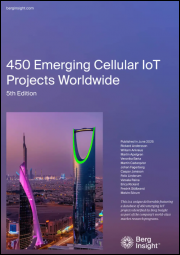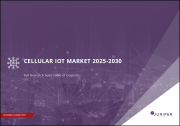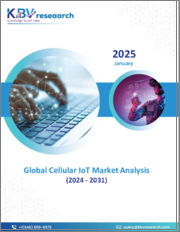
|
시장보고서
상품코드
1453741
세계의 셀룰러 IoT 시장 : 규모 및 예측 - 네트워크, 연결, 용도, 최종사용자, 지역별 분석(2023-2030년)Global Cellular IoT Market Size Study & Forecast, by Network, by Connection, by Application, by End-user, and Regional Analysis, 2023-2030 |
||||||
세계 셀룰러 IoT 시장 규모는 2022년 약 44억 달러에 달했고, 예측 기간인 2023-2030년 동안 23.4% 이상의 견조한 성장률을 나타낼 것으로 전망됩니다. 셀룰러 IoT(Cellular Internet of Things)는 LTE-M, NB-IoT, 5G와 같은 셀룰러 네트워크를 활용하여 IoT 기기 간의 연결과 통신을 구축합니다. 이 기술은 IoT 엔드포인트 간의 원활한 데이터 교환을 가능하게 하며, 기존 셀룰러 인프라를 활용하여 안정적이고 안전하며 확장 가능한 연결성을 보장합니다. 셀룰러 IoT는 다양한 산업 분야에서 다양한 이용 사례에 걸쳐 IoT 솔루션을 쉽게 구축할 수 있도록 지원하며, 수많은 커넥티드 디바이스를 지원할 수 있습니다. 셀룰러 IoT의 장점은 커버리지 향상, 배터리 수명 연장, 보안 강화 등 IoT 기술 보급에 중요한 요소로 작용하고 있습니다. 대규모 IoT 구축과 엣지 컴퓨팅의 통합 증가, 감시를 수반하는 국토 안보 분야에서 5G 셀룰러 IoT에 대한 수요 증가, 의료용 웨어러블에서 셀룰러 IoT 모듈의 사용 증가는 전 세계적으로 시장 수요를 촉진하는 가장 두드러진 요인으로 작용하고 있습니다.
스마트 시티, 헬스케어, 농업, 제조, 운송 등 다양한 산업에서 IoT 기기가 빠르게 확산되고 있는 것도 시장 수요를 촉진하는 주요 요인으로 작용하고 있습니다. 셀룰러 네트워크는 이러한 장치에 안정적이고 확장 가능한 연결 솔루션을 제공하며, Statista에 따르면 2019년 전 세계 IoT 연결 장치 수는 약 77억 4,000만 개로 2020년에는 87억 4,000만 개로 증가하고 2030년에는 254억 4, 000만 개에 달할 것으로 예상됩니다. 000만 대에 달할 것으로 예상됩니다. 따라서 이 요인은 셀룰러 IoT 수요와 직결되어 시장 성장을 크게 증가시킬 것으로 보입니다. 또한, 농업 자동화 및 환경 모니터링 분야의 셀룰러 IoT 수요 증가와 5G 네트워크의 급속한 확장은 예측 기간 동안 다양한 유리한 기회를 제공할 것으로 예상됩니다. 그러나 사이버 공격에 대한 우려 증가와 셀룰러 IoT 구축 관리 및 유지보수의 어려움은 2023-2030년의 예측 기간 동안 시장 성장을 저해하는 요인으로 작용할 것으로 예상됩니다.
세계 셀룰러 IoT 시장 조사에서 고려된 주요 지역은 아시아태평양, 북미, 유럽, 라틴아메리카, 중동 및 아프리카 등입니다. 북미는 셀룰러 기술의 지속적인 발전, 사물인터넷(IoT) 기술 채택 증가, 정밀 농업, 스마트 그리드 기술, 첨단 헬스케어 솔루션에서 셀룰러 IoT의 혁신적인 적용으로 인해 2022년 시장을 주도할 것으로 예상됩니다. 반면, 아시아태평양은 예측 기간 동안 가장 높은 CAGR로 성장할 것으로 예상됩니다. 커넥티드 헬스 웨어러블 기기에 대한 수요 급증, 스마트 시티 프로젝트 개발 증가, 5G 인프라의 급속한 발전이 이 지역 전체 시장 수요를 크게 촉진하고 있습니다.
이 조사의 목적은 최근 몇 년동안 다양한 부문과 국가 시장 규모를 정의하고 향후 몇 년동안 시장 규모를 예측하는 것입니다. 이 보고서는 조사 대상 국가의 산업의 질적 및 양적 측면을 포함하도록 설계되었습니다.
또한, 향후 시장 성장을 규정하는 촉진요인과 도전 과제 등 중요한 측면에 대한 자세한 정보를 제공합니다. 또한, 주요 기업들경쟁 구도와 제품 제공에 대한 상세한 분석과 함께 이해관계자들이 투자할 수 있는 미시적 시장에서의 잠재적 기회도 포함하고 있습니다.
목차
제1장 주요 요약
제2장 세계의 셀룰러 IoT 시장 정의와 범위
- 조사 목적
- 시장 정의와 범위
- 업계 진화
- 조사 범위
- 조사 대상년
- 통화 환산율
제3장 세계의 셀룰러 IoT 시장 역학
- 셀룰러 IoT 시장 영향 분석(2020년-2030년)
- 시장 성장 촉진요인
- 시장이 해결해야 할 과제
- 시장 기회
제4장 세계의 셀룰러 IoT 시장 산업 분석
- Porter's Five Forces 모델
- 공급 기업의 교섭력
- 바이어의 교섭력
- 신규 진출업체의 위협
- 대체품의 위협
- 경쟁 기업간 경쟁 관계
- Porter's Five Forces의 영향 분석
- PEST 분석
- 정치
- 경제
- 사회
- 기술
- 환경
- 법률
- 주요 투자 기회
- 주요 성공 전략
- COVID-19의 영향 분석
- 파괴적 동향
- 업계 전문가의 견해
- 애널리스트의 결론 및 제안
제5장 세계의 셀룰러 IoT 시장 : 네트워크별
- 시장 현황
- 세계의 셀룰러 IoT 시장 : 네트워크별, 실적-가능성 분석
- 세계의 셀룰러 IoT 시장 : 네트워크별, 추정·예측(2020년-2030년)
- 셀룰러 IoT 시장 : 하위 부문 분석
- 2G/3G
- 4G
- LTE-M
- 5G
- NB-IoT
제6장 세계의 셀룰러 IoT 시장 : 접속별
- 시장 현황
- 세계의 셀룰러 IoT 시장 : 접속별, 실적-가능성 분석
- 세계의 셀룰러 IoT 시장 : 접속별, 추정·예측(2020년-2030년)
- 셀룰러 IoT 시장 : 하위 부문 분석
- Wi-Fi
- 브로드밴드
- 위성
- 케이블
- 기타
제7장 세계의 셀룰러 IoT 시장 : 용도별
- 시장 현황
- 세계의 셀룰러 IoT 시장 : 용도별, 실적-가능성 분석
- 세계의 셀룰러 IoT 시장 : 용도별, 추정·예측(2020년-2030년)
- 셀룰러 IoT 시장 : 하위 부문 분석
- Broadband IoT
- Massive IoT
- Industrial Automation
- Critical IoT
제8장 셀룰러 IoT 시장 : 최종사용자별
- 시장 현황
- 세계의 셀룰러 IoT 시장 : 최종사용자별, 실적-가능성 분석
- 세계의 셀룰러 IoT 시장 : 최종사용자별, 추정·예측(2020년-2030년)
- 셀룰러 IoT 시장 : 하위 부문 분석
- 개인
- 상업/기업
- 산업
제9장 세계의 셀룰러 IoT 시장 : 지역 분석
- 주요 국가
- 주요 신흥 국가
- 셀룰러 IoT 시장 : 지역 시장 현황
- 북미
- 미국
- 네트워크 추정·예측(2020년-2030년)
- 접속 추정·예측(2020년-2030년)
- 용도 추정·예측(2020년-2030년)
- 최종사용자 추정·예측(2020년-2030년)
- 캐나다
- 미국
- 유럽
- 영국
- 독일
- 프랑스
- 스페인
- 이탈리아
- 기타 유럽
- 아시아태평양
- 중국
- 인도
- 일본
- 호주
- 한국
- 기타 아시아태평양
- 라틴아메리카
- 브라질
- 멕시코
- 중동 및 아프리카
- 사우디아라비아
- 남아프리카공화국
- 기타 중동 및 아프리카
제10장 경쟁 정보
- 주요 기업의 SWOT 분석
- 주요 시장 전략
- 기업 개요
- Qualcomm Incorporated(U.S.)
- Sierra Wireless(Canada)
- Telit Communications(Thales Group)(U.K.)
- Nordic Semiconductor ASA(Norway)
- AT&T Corporation(U.S.)
- Nokia Corporation(Finland)
- Telefonaktiebolaget LM Ericsson(Sweden)
- Huawei Technologies Co., Ltd.(China)
- Zhongxing New Telecommunications Equipment Co., Ltd.(China)
- China Mobile Communications Group Co., Ltd.(China)
제11장 조사 과정
- 조사 과정
- 데이터 마이닝
- 분석
- 시장 추정
- 검증
- 출판
- 조사 속성
- 조사의 전제조건
Global Cellular IoT Market is valued at approximately USD 4.40 billion in 2022 and is anticipated to grow with a healthy growth rate of more than 23.4% during the forecast period 2023-2030. Cellular IoT, or Cellular Internet of Things, utilizes cellular networks such as LTE-M, NB-IoT, and 5G to establish connectivity and communication among IoT devices. This technology enables the seamless exchange of data between IoT endpoints, ensuring reliable, secure, and scalable connectivity leveraging existing cellular infrastructure. Cellular IoT facilitates the deployment of IoT solutions across diverse use cases with applications in various industries, supporting a multitude of connected devices. Its advantages include improved coverage, extended battery life, and enhanced security, making it a key enabler for the widespread adoption of IoT technologies. The rising integration of edge computing with massive IoT deployments, increasing demand for 5G cellular IoT in homeland security with surveillance, and increasing application of cellular IoT modules in medical wearables are the most prominent factors that are propelling the market demand across the globe.
In addition, the rapid proliferation of IoT devices across various industries, such as smart cities, healthcare, agriculture, manufacturing, and transportation is a significant driving factor for the market demand. Cellular networks provide a reliable and scalable connectivity solution for these devices. According to Statista, in 2019, globally, there were around 7.74 billion IoT-connected devices, which increased to 8.74 billion devices in the year 2020 and is expected to reach 25.44 billion by the year 2030. Thus, this factor is directly associated with the demand for cellular IoT, which, in turn, augments the market growth at a substantial rate. Moreover, the rise in demand for cellular IoT in agricultural automation and environmental monitoring, as well as the surging expansion of 5G networks presents various lucrative opportunities over the forecast years. However, the growing concern regarding cyberattacks and the difficulties in the management and maintenance of cellular IoT deployments are hindering market growth throughout the forecast period of 2023-2030.
The key regions considered for the Global Cellular IoT Market study include Asia Pacific, North America, Europe, Latin America, and Middle East & Africa. North America dominated the market in 2022 owing to the ongoing advancements in cellular technology, increasing adoption of Internet of Things (IoT) technologies, as well as innovative applications of Cellular IoT in precision agriculture, smart grid technologies, and advanced healthcare solutions. Whereas, Asia Pacific is expected to grow at the highest CAGR during the forecast years. The soaring demand for connected health wearable devices, the increase in deployment of smart city projects and the rapid development of 5G infrastructure are significantly propelling the market demand across the region.
Major market players included in this report are:
- Qualcomm Incorporated (U.S.)
- Sierra Wireless (Canada)
- Telit Communications (Thales Group) (U.K.)
- Nordic Semiconductor ASA (Norway)
- AT&T Corporation (U.S.)
- Nokia Corporation (Finland)
- Telefonaktiebolaget LM Ericsson (Sweden)
- Huawei Technologies Co., Ltd. (China)
- Zhongxing New Telecommunications Equipment Co., Ltd. (China)
- China Mobile Communications Group Co., Ltd. (China)
Recent Developments in the Market:
- In January 2024, Nordic Semiconductor introduced its latest IoT innovations and showcased demonstrations featuring low-power Wi-Fi, LE Audio, Matter, and power management at CES 2024 in Norway. These showcased products encompass essential IoT technologies including cellular IoT (LTE-M and NB-IoT), low-power Wi-Fi, Matter, DECT NR+, and Bluetooth Low Energy (Bluetooth LE), highlighting the company's noteworthy impact on the evolving IoT landscape at CES.
- In November 2023, Telenor partnered with Polarium to deliver globally managed IoT connectivity services tailored for energy storage solutions. This partnership empowered Polarium to utilize Telenor's sophisticated cellular-managed connectivity, enabling the provision of a wide array of digital solutions. These offerings encompass fleet management, anti-theft measures, remote monitoring, and tracking services, ensuring comprehensive coverage for energy storage systems.
- In November 2023, CommScope and STMicroelectronics collaborated to integrate CommScope's PKIWorks IoT security platform with ST's STM32WB MCU (microcontroller unit). This partnership aimed to streamline the development of secure IoT devices, resulting in cost and time savings. The integration simplified the manufacturing of matter-device credentials and allowed commissioning at the MCU level without the need for developer intervention.
Global Cellular IoT Market Report Scope:
- Historical Data - 2020 - 2021
- Base Year for Estimation - 2022
- Forecast period - 2023-2030
- Report Coverage - Revenue forecast, Company Ranking, Competitive Landscape, Growth factors, and Trends
- Segments Covered - Network, Connection, Application, End-user, Region
- Regional Scope - North America; Europe; Asia Pacific; Latin America; Middle East & Africa
- Customization Scope - Free report customization (equivalent up to 8 analyst's working hours) with purchase. Addition or alteration to country, regional & segment scope*
The objective of the study is to define market sizes of different segments & countries in recent years and to forecast the values to the coming years. The report is designed to incorporate both qualitative and quantitative aspects of the industry within countries involved in the study.
The report also caters detailed information about the crucial aspects such as driving factors & challenges which will define the future growth of the market. Additionally, it also incorporates potential opportunities in micro markets for stakeholders to invest along with the detailed analysis of competitive landscape and product offerings of key players. The detailed segments and sub-segment of the market are explained below:
By Network:
- 2G/3G
- 4G
- LTE-M
- 5G
- NB-IoT
By Connection:
- Wi-Fi
- Broadband
- Satellite
- Cable
- Others
By Application:
- Broadband IoT
- Massive IoT
- Industrial Automation
- Critical IoT
By End-user:
- Individual
- Commercial/Enterprise
- Industrial
By Region:
- North America
- U.S.
- Canada
- Europe
- UK
- Germany
- France
- Spain
- Italy
- ROE
- Asia Pacific
- China
- India
- Japan
- Australia
- South Korea
- RoAPAC
- Latin America
- Brazil
- Mexico
- Middle East & Africa
- Saudi Arabia
- South Africa
- Rest of Middle East & Africa
Table of Contents
Chapter 1.Executive Summary
- 1.1.Market Snapshot
- 1.2.Global & Segmental Market Estimates & Forecasts, 2020-2030 (USD Billion)
- 1.2.1.Cellular IoT Market, by Region, 2020-2030 (USD Billion)
- 1.2.2.Cellular IoT Market, by Network, 2020-2030 (USD Billion)
- 1.2.3.Cellular IoT Market, by Connection, 2020-2030 (USD Billion)
- 1.2.4.Cellular IoT Market, by Application, 2020-2030 (USD Billion)
- 1.2.5.Cellular IoT Market, by End-user, 2020-2030 (USD Billion)
- 1.3.Key Trends
- 1.4.Estimation Methodology
- 1.5.Research Assumption
Chapter 2.Global Cellular IoT Market Definition and Scope
- 2.1.Objective of the Study
- 2.2.Market Definition & Scope
- 2.2.1.Industry Evolution
- 2.2.2.Scope of the Study
- 2.3.Years Considered for the Study
- 2.4.Currency Conversion Rates
Chapter 3.Global Cellular IoT Market Dynamics
- 3.1.Cellular IoT Market Impact Analysis (2020-2030)
- 3.1.1.Market Drivers
- 3.1.1.1.Rapid proliferation of IoT devices across various industries
- 3.1.1.2.Increasing application of cellular IoT modules in medical wearables
- 3.1.2.Market Challenges
- 3.1.2.1.Growing concern regarding cyberattacks
- 3.1.2.2.Difficulties in management and maintenance of cellular IoT deployments
- 3.1.3.Market Opportunities
- 3.1.3.1.Rise in demand for cellular IoT in agricultural automation and environmental monitoring
- 3.1.3.2.Surging expansion of 5G networks
- 3.1.1.Market Drivers
Chapter 4.Global Cellular IoT Market Industry Analysis
- 4.1.Porter's 5 Force Model
- 4.1.1.Bargaining Power of Suppliers
- 4.1.2.Bargaining Power of Buyers
- 4.1.3.Threat of New Entrants
- 4.1.4.Threat of Substitutes
- 4.1.5.Competitive Rivalry
- 4.2.Porter's 5 Force Impact Analysis
- 4.3.PEST Analysis
- 4.3.1.Political
- 4.3.2.Economical
- 4.3.3.Social
- 4.3.4.Technological
- 4.3.5.Environmental
- 4.3.6.Legal
- 4.4.Top investment opportunity
- 4.5.Top winning strategies
- 4.6.COVID-19 Impact Analysis
- 4.7.Disruptive Trends
- 4.8.Industry Expert Perspective
- 4.9.Analyst Recommendation & Conclusion
Chapter 5.Global Cellular IoT Market, by Network
- 5.1.Market Snapshot
- 5.2.Global Cellular IoT Market by Network, Performance - Potential Analysis
- 5.3.Global Cellular IoT Market Estimates & Forecasts by Network 2020-2030 (USD Billion)
- 5.4.Cellular IoT Market, Sub Segment Analysis
- 5.4.1.2G/3G
- 5.4.2.4G
- 5.4.3.LTE-M
- 5.4.4.5G
- 5.4.5.NB-IoT
Chapter 6.Global Cellular IoT Market, by Connection
- 6.1.Market Snapshot
- 6.2.Global Cellular IoT Market by Connection, Performance - Potential Analysis
- 6.3.Global Cellular IoT Market Estimates & Forecasts by Connection 2020-2030 (USD Billion)
- 6.4.Cellular IoT Market, Sub Segment Analysis
- 6.4.1.Wi-Fi
- 6.4.2.Broadband
- 6.4.3.Satellite
- 6.4.4.Cable
- 6.4.5.Others
Chapter 7.Global Cellular IoT Market, by Application
- 7.1.Market Snapshot
- 7.2.Global Cellular IoT Market by Application, Performance - Potential Analysis
- 7.3.Global Cellular IoT Market Estimates & Forecasts by Application 2020-2030 (USD Billion)
- 7.4.Cellular IoT Market, Sub Segment Analysis
- 7.4.1.Broadband IoT
- 7.4.2.Massive IoT
- 7.4.3.Industrial Automation
- 7.4.4.Critical IoT
Chapter 8.Cellular IoT Market, by End-user
- 8.1.Market Snapshot
- 8.2.Global Cellular IoT Market by End-user, Performance - Potential Analysis
- 8.3.Global Cellular IoT Market Estimates & Forecasts by End-user 2020-2030 (USD Billion)
- 8.4.Cellular IoT Market, Sub Segment Analysis
- 8.4.1.Individual
- 8.4.2.Commercial/Enterprise
- 8.4.3.Industrial
Chapter 9.Global Cellular IoT Market, Regional Analysis
- 9.1.Top Leading Countries
- 9.2.Top Emerging Countries
- 9.3.Cellular IoT Market, Regional Market Snapshot
- 9.4.North America Cellular IoT Market
- 9.4.1.U.S. Cellular IoT Market
- 9.4.1.1.Network breakdown estimates & forecasts, 2020-2030
- 9.4.1.2.Connection breakdown estimates & forecasts, 2020-2030
- 9.4.1.3.Application breakdown estimates & forecasts, 2020-2030
- 9.4.1.4.End-user breakdown estimates & forecasts, 2020-2030
- 9.4.2.Canada Cellular IoT Market
- 9.4.1.U.S. Cellular IoT Market
- 9.5.Europe Cellular IoT Market Snapshot
- 9.5.1.U.K. Cellular IoT Market
- 9.5.2.Germany Cellular IoT Market
- 9.5.3.France Cellular IoT Market
- 9.5.4.Spain Cellular IoT Market
- 9.5.5.Italy Cellular IoT Market
- 9.5.6.Rest of Europe Cellular IoT Market
- 9.6.Asia-Pacific Cellular IoT Market Snapshot
- 9.6.1.China Cellular IoT Market
- 9.6.2.India Cellular IoT Market
- 9.6.3.Japan Cellular IoT Market
- 9.6.4.Australia Cellular IoT Market
- 9.6.5.South Korea Cellular IoT Market
- 9.6.6.Rest of Asia Pacific Cellular IoT Market
- 9.7.Latin America Cellular IoT Market Snapshot
- 9.7.1.Brazil Cellular IoT Market
- 9.7.2.Mexico Cellular IoT Market
- 9.8.Middle East & Africa Cellular IoT Market
- 9.8.1.Saudi Arabia Cellular IoT Market
- 9.8.2.South Africa Cellular IoT Market
- 9.8.3.Rest of Middle East & Africa Cellular IoT Market
Chapter 10.Competitive Intelligence
- 10.1.Key Company SWOT Analysis
- 10.1.1.Company 1
- 10.1.2.Company 2
- 10.1.3.Company 3
- 10.2.Top Market Strategies
- 10.3.Company Profiles
- 10.3.1.Qualcomm Incorporated (U.S.)
- 10.3.1.1.Key Information
- 10.3.1.2.Overview
- 10.3.1.3.Financial (Subject to Data Availability)
- 10.3.1.4.Product Summary
- 10.3.1.5.Recent Developments
- 10.3.2.Sierra Wireless (Canada)
- 10.3.3.Telit Communications (Thales Group) (U.K.)
- 10.3.4.Nordic Semiconductor ASA (Norway)
- 10.3.5.AT&T Corporation (U.S.)
- 10.3.6.Nokia Corporation (Finland)
- 10.3.7.Telefonaktiebolaget LM Ericsson (Sweden)
- 10.3.8.Huawei Technologies Co., Ltd. (China)
- 10.3.9.Zhongxing New Telecommunications Equipment Co., Ltd. (China)
- 10.3.10.China Mobile Communications Group Co., Ltd. (China)
- 10.3.1.Qualcomm Incorporated (U.S.)
Chapter 11.Research Process
- 11.1.Research Process
- 11.1.1.Data Mining
- 11.1.2.Analysis
- 11.1.3.Market Estimation
- 11.1.4.Validation
- 11.1.5.Publishing
- 11.2.Research Attributes
- 11.3.Research Assumption



















